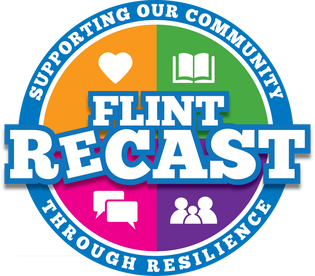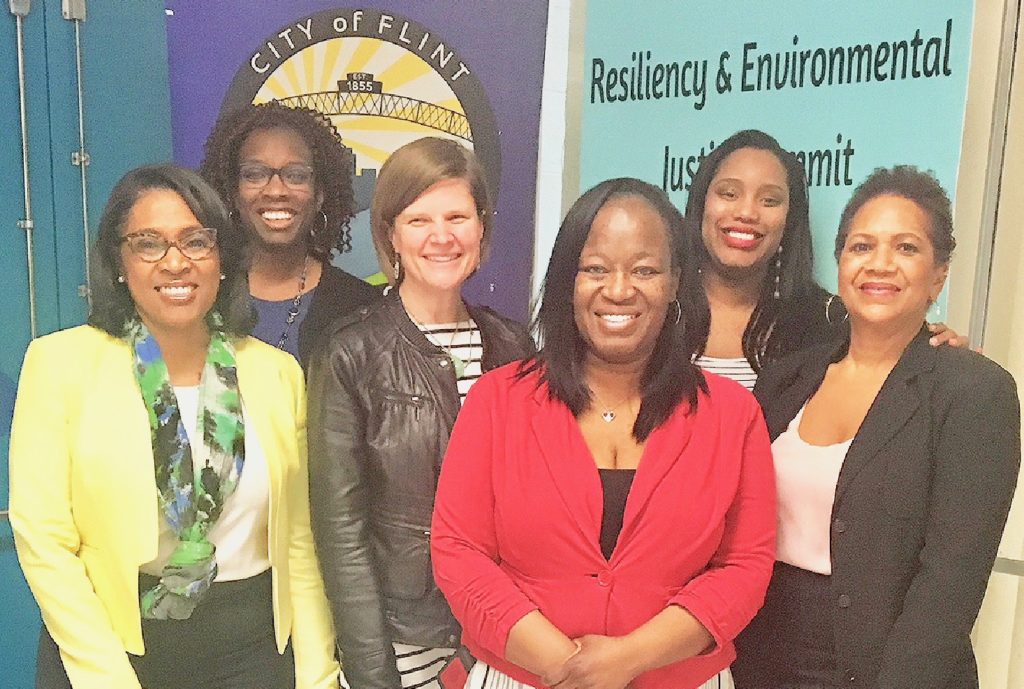By Patsy Isenberg
Flint residents are feeling somewhat better about the city’s recovery from the water crisis than in the challenging days when it first started in 2014, according to a panel of city officials at last week’s 3rd Annual Resiliency and Environmental Justice Summit, subtitled “Shine Your Light.”
 But results from interviews and surveys from several hundred residents with representation from all nine wards last year suggest many needs and concerns remain, including access to grocery stores, the quality of Flint schools, ongoing communication with the city about the water crisis, and property upkeep and street cleaning.
But results from interviews and surveys from several hundred residents with representation from all nine wards last year suggest many needs and concerns remain, including access to grocery stores, the quality of Flint schools, ongoing communication with the city about the water crisis, and property upkeep and street cleaning.
The summit was a project of Flint ReCAST (Resiliency in Communities After Stress and Trauma) a partnership of the City of Flint, Michigan State University, the University of Michigan-Flint and Genesee Health System.
It is funded for five years through 2021 from a $4.9 million grant from the federal Substance Abuse and Mental Health Services Administration (SAMHSA).
The confab brought residents, community leaders, health professionals and volunteers together to delve into the city’s resilience after trauma once again. The event took place March 27-30 and offered workshops, speakers and panels about assuring the wellbeing after trauma of adolescents and disrupted families; creating sustainable and inclusive local communities, advancing “just utilities” and “ensuring an equity stake for all.”
Most of the programs were held at Flint Southwestern Academy where students were on spring break. In addition to its workshops and presentations, the summit included food, movies, and a talent show at McCree on Friday night featuring Flint’s youth.
The first scheduled session March 27 was a “Healthy Schools Discussion.” Later in the afternoon “On the Road to Recovery,” an interactive community meeting with speakers from the City of Flint who also are participants in ReCAST was offered.

“Road to Recovery” panelists (from left) Pamela Pugh, Marijata Daniel-Echols, Julia Heamy, Jameca Patrick-Singleton, Candice Mushatt and Linnette Phiiips (Photo by Patsy Isenberg)
About 20 diverse people attended the “On the Road to Recovery” session, which included presentations by four City of Flint officials: Candice Mushatt, public information officer; Dr. Pamela Pugh, chief public health advisor and co-director of the overall ReCAST program; Linnette Philips, deputy director of economic development; and Jameca Patrick-Singleton, chief recovery officer.
Assisting them were were Julia Heamy and Marijata Daniel-Echols from ReCAST who also kicked off the session and introduced the first presenter.
All four presenters said they are working in newly created positions through appointments by Mayor Karen Weaver because of needs that arose during the water crisis.
The four reported on outcomes and findings from “one-on-one” interviews with between 300 and 400 residents from a series of town halls last year and presented powerpoint visuals and handouts summarizing the results.
Asked for clarification about the numbers and process afterwards, Mushatt said, “The Community One-on-One’s were held May through June of 2018. The residents took 3 surveys during the 90-minute sessions which were held in a mini town hall type format. They were able to hear from and give feedback to our Public Health Advisor [Pugh] and take a survey about public health communications; in addition, they heard from and gave feedback to our Chief Recovery Officer [Singleton] and The Deputy Director of Economic Development [Phillips] and took surveys on these two topics as well.”
Questions included how residents rate what’s been done so far to improve the city post-trauma, along with demographic statistics.
Residents also were asked for input about the future needs of the city and what steps should be taken next. Mushatt pointed out that each ward has a different demographic, therefore different needs.
Mushatt said she was hired specifically to try to improve communication with residents about water crisis-related issues, such as what services were available, where to find the PODs (point of distribution for bottled water) what were the lead levels, whose homes were being tested, how soon pipes would be replaced. She said officiasl in the City of Flint found there was a gap in hearing from the residents about needed services.
Mushatt said the one-on-one process was developed as a response to these concerns. In April 2018 she, Pugh, Patrick-Singleton and Philips launched the information gathering to hear from residents about what messages were not being communicated.
Pugh reported over half the responders said communication with the city had improved–20 percent said “a lot,” 37 percent said “somewhat” and 30 percent said “a little.” One reason, she speculated, is that the city is now sometimes using social media to get out information; and according to the findings, 74 per cent of those interviewed have social media accounts, and 17 percent said social media are their main source of information, second only to the City of Flint itself at 30 percent. Only 13 percent said they get their information from local publications. About 33 percent said they get “too many different message” about city matters.
Philips said the city’s department of economic development was the first new one created after the water crisis and there hadn’t been a position like hers for 14 years. She said helping conduct the one-on-ones was a great opportunity to go out into the community and find out what the residents wanted in terms of economic development which includes job creation and creating vibrant communities, safe neighborhoods, and walkable space.
She said economic data from the interviews centered on how long residents remained in their area or ward, employment or retirement status, median age, and how many are business owners. Of the total, 75 percent reported they were employed full time. Of the 24 percent unemployed, 65 percent said they were retired.
The number one issue that vaulted to the top of the list of concerns was grocery stores, she noted, at 21 percent.
Concerns about schools were second on the list of concerns at 15 percent, including many respondents who identify as retired. Philips attributed that to schools impacting property taxes and home values. Other needs reported were street cleaning, snowplowing and landscaping, transportation. “They want to see that people are taking care of their property.”
Patrick-Singleton said one thing she noted in the data was whether residents wanted to participate in developing plans for future action for water crisis recovery. She said “there wasn’t a plan that was overwhelmingly Flint-resident driven.”
Residents were asked if they wanted a “Flint- driven” plan. Almost 72 percent of residents said yes and wanted to be involved.
Thus Patrick-Singleton is developing “Future Flint,” what she described as “a resident-driven recovery plan.” She said it would be “a comprehensive and sustainable plan that will move the residents of Flint toward a collaborative and community-driven recovery.”
Attendees then were invited to participate in the process by breaking up into groups of three or four to briefly brainstorm elements of that “resident-driven plan,” and offer thought about Flint’s needs, with their ideas added into formation of the plan.

Resiliency Summit participants in small group discussion (from left) Mary Sequin, Kay Doerr, Tom Haley and Virginia Nolan (Photo by Patsy Isenberg)
“We will continue to have these interactive dialogs and we cannot say enough about the work that we are doing as a result of what we are hearing from you. So we are appreciative of you all being here, giving us input and just listening to where we are with what you’ve given us already,” Pugh said.
Panelists concluded by noting that an improved website for the City of Flint will go live in early April. The presenters’ email addresses will be listed on the site at www.cityofflint.com. ReCAST’s website is www.flintrecast.com for information about the 3rd Annual Resiliency & Environmental Justice Summit.
Editor’s Note: This story has been updated April 1 to clarify the process used for the data collection reported by the panel, based on information from Mushatt. The total number of surveys/interviews conducted was between 300 and 400, she said, not between 300 and 400 from each ward.
EVM staff writer Patsy Isenberg can be reached at pisenvber@gmail.com. EVM Editor Jan Worth-Nelson contributed to this report and is available at janworth1118@gmail.com.


You must be logged in to post a comment.